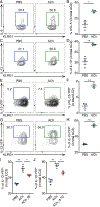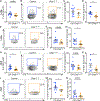The ChAT-acetylcholine pathway promotes group 2 innate lymphoid cell responses and anti-helminth immunity
- PMID: 33674322
- PMCID: PMC8577047
- DOI: 10.1126/sciimmunol.abe3218
The ChAT-acetylcholine pathway promotes group 2 innate lymphoid cell responses and anti-helminth immunity
Abstract
Group 2 innate lymphoid cells (ILC2s) reside in multiple tissues, including lymphoid organs and barrier surfaces, and secrete type 2 cytokines including interleukin-5 (IL-5), IL-9, and IL-13. These cells participate in multiple physiological processes including allergic inflammation, tissue repair, metabolic homeostasis, and host defense against helminth infections. Recent studies indicate that neurotransmitters and neuropeptides can play an important role in regulating ILC2 responses; however, the mechanisms that underlie these processes in vivo remain incompletely defined. Here, we identify that activated ILC2s up-regulate choline acetyltransferase (ChAT)-the enzyme responsible for the biosynthesis of acetylcholine (ACh)-after infection with the helminth parasite Nippostrongylus brasiliensis or treatment with alarmins or cytokines including IL-25, IL-33, and thymic stromal lymphopoietin (TSLP). ILC2s also express acetylcholine receptors (AChRs), and ACh administration promotes ILC2 cytokine production and elicits expulsion of helminth infection. In accordance with this, ChAT deficiency in ILC2s leads to defective ILC2 responses and impaired immunity against helminth infection. Together, these results reveal a previously unrecognized role of the ChAT-ACh pathway in promoting type 2 innate immunity to helminth infection.
Copyright © 2021 The Authors, some rights reserved; exclusive licensee American Association for the Advancement of Science. No claim to original U.S. Government Works.
Conflict of interest statement
Figures








Similar articles
-
Acetylcholine production by group 2 innate lymphoid cells promotes mucosal immunity to helminths.Sci Immunol. 2021 Mar 5;6(57):eabd0359. doi: 10.1126/sciimmunol.abd0359. Sci Immunol. 2021. PMID: 33674321
-
Intrinsic functional defects of type 2 innate lymphoid cells impair innate allergic inflammation in promyelocytic leukemia zinc finger (PLZF)-deficient mice.J Allergy Clin Immunol. 2016 Feb;137(2):591-600.e1. doi: 10.1016/j.jaci.2015.07.050. Epub 2015 Oct 23. J Allergy Clin Immunol. 2016. PMID: 26602165 Free PMC article.
-
ILC2s-Trailblazers in the Host Response Against Intestinal Helminths.Front Immunol. 2019 Apr 4;10:623. doi: 10.3389/fimmu.2019.00623. eCollection 2019. Front Immunol. 2019. PMID: 31019505 Free PMC article. Review.
-
The Heterogeneity, Origins, and Impact of Migratory iILC2 Cells in Anti-helminth Immunity.Front Immunol. 2020 Jul 23;11:1594. doi: 10.3389/fimmu.2020.01594. eCollection 2020. Front Immunol. 2020. PMID: 32793230 Free PMC article. Review.
-
Regulation of metabolic health and adipose tissue function by group 2 innate lymphoid cells.Eur J Immunol. 2016 Jun;46(6):1315-25. doi: 10.1002/eji.201545562. Epub 2016 May 17. Eur J Immunol. 2016. PMID: 27120716 Free PMC article. Review.
Cited by
-
Spinal Cord Injury Impairs Lung Immunity in Mice.J Immunol. 2022 Jul 1;209(1):157-170. doi: 10.4049/jimmunol.2200192. Epub 2022 Jun 13. J Immunol. 2022. PMID: 35697382 Free PMC article.
-
Communication is key: Innate immune cells regulate host protection to helminths.Front Immunol. 2022 Sep 26;13:995432. doi: 10.3389/fimmu.2022.995432. eCollection 2022. Front Immunol. 2022. PMID: 36225918 Free PMC article. Review.
-
Sensory sentinels: Neuroimmune detection and food allergy.Immunol Rev. 2024 Sep;326(1):83-101. doi: 10.1111/imr.13375. Epub 2024 Aug 2. Immunol Rev. 2024. PMID: 39092839 Review.
-
Neuroimmune Interactions in Peripheral Organs.Annu Rev Neurosci. 2022 Jul 8;45:339-360. doi: 10.1146/annurev-neuro-111020-105359. Epub 2022 Apr 1. Annu Rev Neurosci. 2022. PMID: 35363534 Free PMC article. Review.
-
Tissue-specific immunity in helminth infections.Mucosal Immunol. 2022 Jun;15(6):1212-1223. doi: 10.1038/s41385-022-00531-w. Epub 2022 Jun 9. Mucosal Immunol. 2022. PMID: 35680972 Free PMC article. Review.
References
Publication types
MeSH terms
Substances
Grants and funding
LinkOut - more resources
Full Text Sources
Other Literature Sources
Molecular Biology Databases

